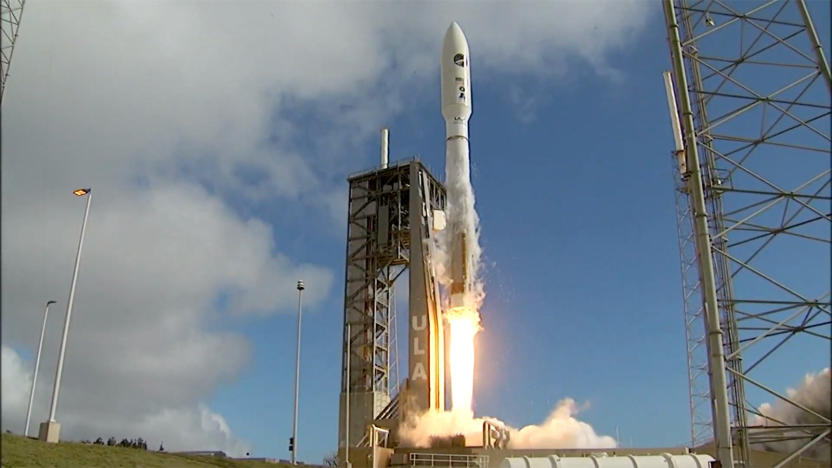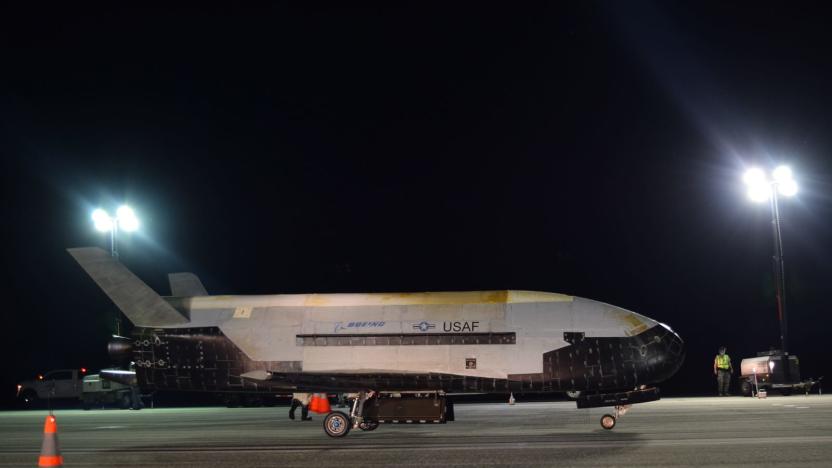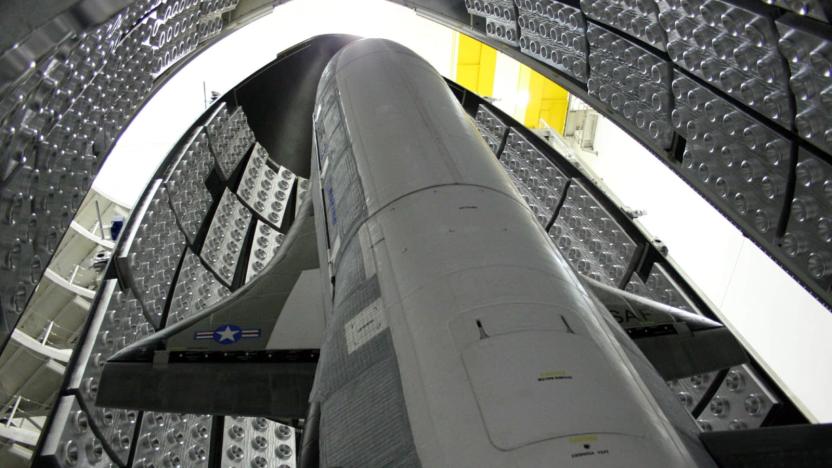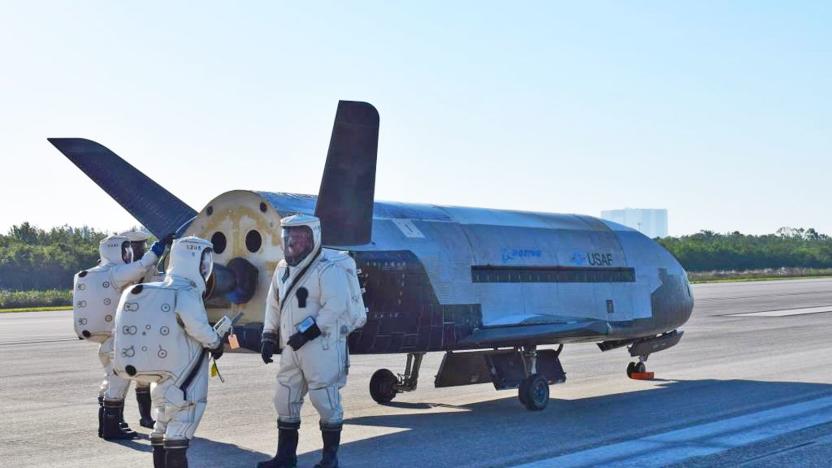X-37B
Latest

X-37B space plane launches on its most ambitious mission to date
The X-37B space plane has launched carrying its most experiments ever -- and an endurance record to challenge.

Air Force's mysterious X-37B space plane heads back to orbit May 16th
The US Air Force's X-37B space plane is heading back to Low Earth Orbit after a record-breaking fifth mission last year.

Air Force's X-37B space plane lands after record 780 days in orbit
There was no doubt that the US Air Force's X-37B was going to break its own record for time spent in orbit, but it's now clear by how much. The mysterious Boeing-made space plane has landed at Kennedy Space Center after 780 days in orbit, comfortably surpassing the earlier record of 717 days, 20 hours and 42 minutes. That's more than three times the 240 days originally expected from the reusable vehicle, which just finished its fifth mission.

The Air Force’s secret space plane sets a new record: 718 days in orbit
The U.S. Air Force's X-37B space plane has been orbiting Earth since September 7th, 2017, crossing the 718 day mark and breaking its previous record of 717 days, 20 hours and 42 minutes in flight. While little is known about the classified X-37B, we do know that it's able to stay in operation for such long stretches of time thanks in part to its solar panels and a lack of a human crew.

SpaceX will launch a secretive space drone for the Air Force
SpaceX fought hard for the right to launch Air Force projects and it has landed a pretty prestigious one. Elon Musk's company will fire the X-37B miniature spaceplane into orbit with the Falcon 9, taking over from the reliable Atlas V built by United Launch Alliance, according to Reuters. And here's the kicker: It will launch the space shuttle-like drone in just two months, meaning it will be SpaceX's first mission for the Air Force.

Drone is the first spacecraft in years to use a key Shuttle runway
Kennedy Space Center is slowly coming back to life, but you almost wouldn't know it by looking at the Shuttle Landing Facility. While it has seen some limited use for aircraft in recent years, it hasn't been used for an orbital mission landing since... well, the last Space Shuttle in 2011. At last, though, it's back to serving its core purpose. The US Air Force's X-37B space drone has touched down at the facility after completing its fourth mission. The highly secretive, autonomous spacecraft could have landed as early as February, but stayed aloft those extra few months for unknown reasons.

Secretive space drone used to test futuristic propulsion system
Ask someone in the street what they know about the Air Force's top-secret space plane and you'll probably wind up getting pinched by the NSA. Nobody can claim to know much about the X-37B, beyond the fact that it's the force's long-term space vehicle, capable of staying in orbit for more than a year at a time. In the run up to the craft's next jaunt around the planet, however, someone has let slip the details of an experiment that it'll be carrying out. According to Spaceflight Now, Air Force officials have revealed that the autonomous drone will be used as the test-bed for a new type of Hall effect thruster.

Air Force's mysterious space drone returns after two years in orbit
Following its longest-ever mission by far, the 11,000 pound X-37B unmanned spacecraft has returned to Earth bearing... well, we don't actually know. You see, after NASA and Boeing developed the craft (about a fifth the size of the Space Shuttle), it bounced over to the Air Force, which is using it for top-secret missions. The X-37B's longest previous flight lasted about 15 months, and this time, it stayed in orbit just shy of two years. As for what it was doing up there, exactly, cue the speculation. Some experts think it was launching spy gear from the pickup-bed-sized payload bay, while others believe it was designed to capture or impair enemy satellites. The Air Force denies all that, saying it was just testing space tech like advanced guidance, robotic systems and autonomous orbital flight. It certainly nailed the latter -- with no human at the controls, the X-37B made a perfect touchdown following a 218 mile-high descent. To see it, check the all-too-brief video below. [Image credit: Boeing]

USAF relaunches its first X-37B on a slightly less mysterious spaceflight
The US Air Force's aims with each X-37B mission continue to be shrouded in secrecy, but we're learning a little more now that it has launched the autonomous space plane for a third time. In once more flying the OTV-1, the original vehicle that reached orbit in 2010, the military branch is clear that testing reusability is a major goal: it wants to know if these spacecraft can take more than one trip without suffering ill effects. We likewise know that navigation, re-entry and other basics will be under scrutiny, even if the military won't talk about the payload. Just when we'll see OTV-1 back on Earth is another matter. The USAF is still standing by its official line that the X-37B is built to stay spaceborne for nine months, but it's remaining open to longer missions if conditions permit. Given that OTV-2 took more than a year to return, we wouldn't be surprised if we're just becoming comfortable with 2014 by the time the vehicle's sibling touches down.

X-37B finally touches down, completing its not-so-secret classified mission (video)
After more than a year of circling the globe, the US Air Force's X-37B has finally touched down at Vandenberg Air Force Base in California. The unmanned, reusable space plane spent 469 days in orbit, performing a number of experiments (many of which are classified) before finally ending its lengthy run Saturday. What exactly the military has learned from the extended orbital excursion is unclear, but, like the Mars rovers before it, the X-37B turned out to be far more robust than many had anticipated. Its mission was originally intended to last just nine months, but its operators managed to milk about six more months out of the craft. While we wait to find out what the next step is, enjoy the video of it landing after the break.

Happy Biiiirthday Mr. USAF X-37B Robot Space Plane
The X-37B was only meant to stay up in space for a gestational nine months, but a full year has now passed since launch and the US Air Force apparently has little interest in bringing its baby home. On the contrary: according to Space.com, the plan is to send up another unmanned space plane to keep the X-37B company on its [CLASSIFIED] missions. Whatever it's getting up to in that airless playground, it must be doing something right. Air Force Lt. Col. Tom McIntyre says the craft is "setting the standard for a reusable space plane and, on this one-year orbital milestone, has returned great value on the experimental investment." Which is a fine way of saying [STILL CLASSIFIED].

Air Force X-37B space plane books additional time on orbital cruise, orders another margarita
If your secret space plane's in orbit and doing its secret thing well enough, why bother bringing it home? This appears to be the mindset of the Air Force regarding its experimental X-37B space plane, the billion-dollar robotic vehicle's orbital flight being extended beyond the 270 days it was initially designed for. While the Air Force has stated that the vehicle is meant only for conducting orbital science experiments, analysts say the X-37B is capable of much more, and could perform additional tasks such as acting as an orbital spy, sneaking up on and tampering with enemy satellites or hauling small batches of supplies to the International Space Station. Perhaps the most interesting thing is that the X-37B could stay in orbit for that much longer. Although the Air Force said last year that the X-37B could last nine months above the heavens before its power and fuel ran out, an inside source commented that "it sips power and fuel like a Prius." Click through the break for the full X-37B schematics, which -- crazily enough -- look nothing like a Prius.

Spy satellites become reluctant space celebs, get their own paparazzi
Not only do American military satellites have to put up with the constant threat of ultrasonic space droppings, now they must also suffer the prying lenses of a couple of Frenchmen. Thierry Legault and Emmanuel Rietsch have spent the past two years turning consumer-grade components into a system that can keep up with the zippy and supposedly secret movements of craft like the X-37B space plane and the NROL-49 low-Earth orbit spy sat. Hit the source link and you'll see videos of the International Space Station, which they also managed to capture with steady-ish focus as it hurtled through space-time. Looks like nothing will thwart these guys, except maybe nano-satellites.

Boeing's new unmanned X-37B launches into orbit, won't come home until it finds Major Tom
Model X-37B might look familiar to you -- it was the name of an autonomous space vehicle that took flight just about a year ago, orbited for a whopping eight months, and then successfully returned to our planet all by itself. Now a new version of the X-37B has blasted off to hang outside of the atmosphere for a while. The spacecraft left Cape Canaveral Launch Complex 41 down in Florida and hurtled to a low-Earth orbit with help of a Atlas V rocket. Boeing isn't saying exactly what it's doing up there, but we suspect this spaceship knows which way to go.

X-37B spaceplane back on earth after 7 months of spying on us, shooting aliens
Look, we don't know what the Air Force sent the unmanned X-37B into space for, or why they didn't offer us a ride, but we're pretty sure whatever it was it was awesome. The spaceplane is now back on solid ground, and apparently it completed all of its orbital objectives during its seven month trip, which were supposedly mostly diagnostic self-tests. According to The Man, anyway. Still, we could swear we spotted some laser blast holes and a self-satisfied, Tom Cruisian smirk on the X-37B when it thought nobody was looking, which confirms all of our worst suspicions: there is extraterrestrial life, and it's totally badass, and only highly trained space fighter jockeys can save us.

Boeing X-37B autonomous space shuttle launched last night, due back 'whenevs'
Boeing's X-37B, the test craft that's been kicking around for the last decade or so, has finally made it into orbit. Formerly a NASA project, we've heard little about the thing since it passed into DARPA hands in 2004 -- and statements like those of the Air Force's Gary Payton don't help much: "in all honesty, we don't know when it's coming back for sure." How's that for autonomous? Also uncommented upon, yet tantalizing, are the military's intentions for the unmanned vehicle, which can remain in orbit 270 days at a time. Spy drone? Orbital weapons platform? Plaything for our future robot overlords? (Let's hope it's not the last one.) The success of the mission will depend on a couple things, namely: how the return trip goes (it should make it back to California's Vandenberg Air Force Base via autopilot... sometime) and whether the thing can be re-launched quickly enough. Ideally, the craft should be ready for another flight in fifteen days. Another test is planned for 2011. [Thanks, One Love!]








